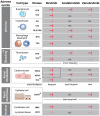Comparative Analysis of BTK Inhibitors and Mechanisms Underlying Adverse Effects
- PMID: 33777941
- PMCID: PMC7991787
- DOI: 10.3389/fcell.2021.630942
Comparative Analysis of BTK Inhibitors and Mechanisms Underlying Adverse Effects
Abstract
The cytoplasmic protein-tyrosine kinase BTK plays an essential role for differentiation and survival of B-lineage cells and, hence, represents a suitable drug target. The number of BTK inhibitors (BTKis) in the clinic has increased considerably and currently amounts to at least 22. First-in-class was ibrutinib, an irreversible binder forming a covalent bond to a cysteine in the catalytic region of the kinase, for which we have identified 228 active trials listed at ClinicalTrials.gov. Next-generation inhibitors, acalabrutinib and zanubrutinib, are approved both in the United States and in Europe, and zanubrutinib also in China, while tirabrutinib is currently only registered in Japan. In most cases, these compounds have been used for the treatment of B-lymphocyte tumors. However, an increasing number of trials instead addresses autoimmunity and inflammation in multiple sclerosis, rheumatoid arthritis, pemphigus and systemic lupus erythematosus with the use of either irreversibly binding inhibitors, e.g., evobrutinib and tolebrutinib, or reversibly binding inhibitors, like fenebrutinib. Adverse effects (AEs) have predominantly implicated inhibition of other kinases with a BTKi-binding cysteine in their catalytic domain. Analysis of the reported AEs suggests that ibrutinib-associated atrial fibrillation is caused by binding to ERBB2/HER2 and ERBB4/HER4. However, the binding pattern of BTKis to various additional kinases does not correlate with the common assumption that skin manifestations and diarrhoeas are off-target effects related to EGF receptor inhibition. Moreover, dermatological toxicities, diarrhoea, bleedings and invasive fungal infections often develop early after BTKi treatment initiation and subsequently subside. Conversely, cardiovascular AEs, like hypertension and various forms of heart disease, often persist.
Keywords: X-linked agammaglobulinemia; acalabrutinib; atrial fibrillation; diarrhoea; ibrutinib; infection; rash; zanubrutinib.
Copyright © 2021 Estupiñán, Berglöf, Zain and Smith.
Conflict of interest statement
The authors declare that the research was conducted in the absence of any commercial or financial relationships that could be construed as a potential conflict of interest.
Figures

 and
and  corresponding to strong and weak inhibition, respectively. ** Major bleedings are more frequent upon ibrutinib treatment versus more selective BTKi. *The association between the kinase inhibition and the side effect is not entirely obvious, since the observed adverse event occurs even if the kinase is not inhibited. EGFR is expressed in the epithelial cells in the gut and skin, but we do not favour a direct association between EGFR-inhibition and diarrhoea/rash. The same is the case for TEC, which is expressed in cardiomyocytes and thrombocytes and not inhibited by acalabrutinib, while the corresponding side effects still occur. HER2 and HER4 are in dashed box, since we favour the association of the simultaneous inhibition of these two kinases with atrial fibrillation. (n.i.) no inhibition. Cardiomyocyte and epithelial cells were created with
corresponding to strong and weak inhibition, respectively. ** Major bleedings are more frequent upon ibrutinib treatment versus more selective BTKi. *The association between the kinase inhibition and the side effect is not entirely obvious, since the observed adverse event occurs even if the kinase is not inhibited. EGFR is expressed in the epithelial cells in the gut and skin, but we do not favour a direct association between EGFR-inhibition and diarrhoea/rash. The same is the case for TEC, which is expressed in cardiomyocytes and thrombocytes and not inhibited by acalabrutinib, while the corresponding side effects still occur. HER2 and HER4 are in dashed box, since we favour the association of the simultaneous inhibition of these two kinases with atrial fibrillation. (n.i.) no inhibition. Cardiomyocyte and epithelial cells were created with Similar articles
-
Bleeding by Bruton Tyrosine Kinase-Inhibitors: Dependency on Drug Type and Disease.Cancers (Basel). 2021 Mar 4;13(5):1103. doi: 10.3390/cancers13051103. Cancers (Basel). 2021. PMID: 33806595 Free PMC article. Review.
-
Cardiovascular events of Bruton's tyrosine kinase inhibitors: A real-world study based on the United States Food and Drug Administration Adverse Event Reporting System database.Br J Clin Pharmacol. 2024 Sep;90(9):2166-2179. doi: 10.1111/bcp.16127. Epub 2024 Jun 3. Br J Clin Pharmacol. 2024. PMID: 38831641
-
Zanubrutinib in patients with previously treated B-cell malignancies intolerant of previous Bruton tyrosine kinase inhibitors in the USA: a phase 2, open-label, single-arm study.Lancet Haematol. 2023 Jan;10(1):e35-e45. doi: 10.1016/S2352-3026(22)00320-9. Epub 2022 Nov 16. Lancet Haematol. 2023. PMID: 36400069 Clinical Trial.
-
Dermatological Toxicities of Bruton's Tyrosine Kinase Inhibitors.Am J Clin Dermatol. 2020 Dec;21(6):799-812. doi: 10.1007/s40257-020-00535-x. Am J Clin Dermatol. 2020. PMID: 32613545 Review.
-
Zanubrutinib in lymphoproliferative disorders: a comprehensive review.Ther Adv Hematol. 2022 May 27;13:20406207221093980. doi: 10.1177/20406207221093980. eCollection 2022. Ther Adv Hematol. 2022. PMID: 35651781 Free PMC article. Review.
Cited by
-
Atypical atrial flutter: Exploring the relationship between ibrutinib chemotherapy and atrial myopathy.HeartRhythm Case Rep. 2023 Nov 4;10(1):104-108. doi: 10.1016/j.hrcr.2023.10.033. eCollection 2024 Jan. HeartRhythm Case Rep. 2023. PMID: 38264120 Free PMC article. No abstract available.
-
A Review of Compartmentalised Inflammation and Tertiary Lymphoid Structures in the Pathophysiology of Multiple Sclerosis.Biomedicines. 2022 Oct 17;10(10):2604. doi: 10.3390/biomedicines10102604. Biomedicines. 2022. PMID: 36289863 Free PMC article. Review.
-
Discovery of a potent BTK and IKZF1/3 triple degrader through reversible covalent BTK PROTAC development.Curr Res Chem Biol. 2022;2:100029. doi: 10.1016/j.crchbi.2022.100029. Epub 2022 May 17. Curr Res Chem Biol. 2022. PMID: 36712232 Free PMC article.
-
Bruton Tyrosine Kinase Inhibitors in B-Cell Malignancies: Their Use and Differential Features.Target Oncol. 2022 Jan;17(1):69-84. doi: 10.1007/s11523-021-00857-8. Epub 2021 Dec 14. Target Oncol. 2022. PMID: 34905129 Free PMC article. Review.
-
A prospective study of zanubrutinib, a Bruton tyrosine kinase inhibitor, in relapsed/refractory idiopathic multicentric Castleman disease.Int J Hematol. 2024 Jun;119(6):631-637. doi: 10.1007/s12185-024-03747-7. Epub 2024 Mar 28. Int J Hematol. 2024. PMID: 38546960 Clinical Trial.
References
-
- Advani R. H., Buggy J. J., Sharman J. P., Smith S. M., Boyd T. E., Grant B., et al. (2013). Bruton tyrosine kinase inhibitor ibrutinib (PCI-32765) has significant activity in patients with relapsed/refractory B-cell malignancies. J. Clin. Oncol. 31 88–94. 10.1200/JCO.2012.42.7906 - DOI - PMC - PubMed
Publication types
LinkOut - more resources
Full Text Sources
Other Literature Sources
Research Materials
Miscellaneous

